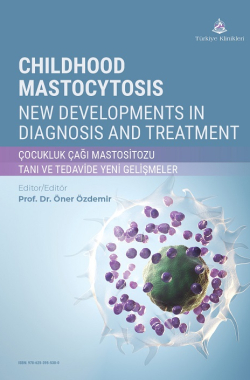CLINICAL DIFFERENCES BETWEEN CHILDHOOD CUTANEOUS MASTOCYTOSIS AND SYSTEMIC MASTOCYTOSIS
Şeyhan Kutluğ
Medical Point Batman Hospital, Department of Pediatric Immunology and Allergy Diseases, Batman, Türkiye
Kutluğ Ş. Clinical Differences Between Childhood Cutaneous Mastocytosis and Systemic Mastocytosis. In: Özdemir Ö, editor. Childhood Mastocytosis: New Developments in Diagnosis and Treatment. 1st ed. Ankara: Türkiye Klinikleri; 2025. p.91-98.
ABSTRACT
Mastocytosis is the clonal proliferation of mast cells in the skin or extracutaneous organs and abnormal surface antigen expression. This neoplastic behavior of mast cells is called cutaneous mastocytosis (CM) if it is in the skin, and systemic mastocytosis (SM) if it is in the extracutaneous organs. CM mostly occurs in childhood, SM more often in adulthood and rarely in childhood. There are some clin- ical differences between childhood and adult CM. Although CM in children mostly occurs in the first 2 years of age, it can occur from the neonatal period to adolescence. In children, CM usually presents with maculopapular lesions that are brownish to reddish in color, slightly itchy, asymmetrically distrib- uted, variable in number, and polymorphic in form. When these rashes are stimulated with itching, it is observed that the redness and swelling increase within 15-30 minutes. This finding is Darier’s sign, a specific clinical finding for CM. Cutaneous findings are sometimes in the form of bullous skin lesions or skin thickening. Most regress until puberty. However, some continue into adulthood. In a small number of cases of childhood CM, mast cell pathology spreads to extracutaneous organs and is called SM. The clinical importance of CM is that it can develop into SM and develop into severe systemic anaphylaxis symptoms and signs due to mast cell mediator release (MCMR) with various triggers. MCMR attacks are accompanied by tachycardia, hypotension, syncope, respiratory symptoms, nausea, abdominal pain, diarrhea, and skin symptoms. SM is the occurrence of mast cell clonal proliferation in one or more extracutaneous organs. Almost all of them involve the bone marrow. In addition, liver, spleen, lymph node, and gastrointestinal system (GIS) involvement may be observed. Clinical signs and symptoms occur depending on the invasion and insufficiency of the affected organs. Therefore, clinical signs and symptoms are quite heterogeneous in SM compared to CM. Asthenia, muscle-joint pain, flushing, urticaria, organomegaly, and GIS system symptoms can be seen in SM. The frequency of systemic anaphylaxis due to MCMR is higher than in CM. The most common and also the best form of SM in clinical practice is indolent systemic mastocytosis (ISM). This form is limited to the bone marrow. It is a silent form and has a good clinical course. However, ISM can evolve into other poor prognosis subtypes of SM. Mortality in SM increases due to both organ failure findings due to organ damage and severe systemic anaphylaxis findings. In addition, some subtypes of SM may undergo my- eloid or leukemic malignant transformation. Therefore, investigating findings related to extracutaneous organ involvement and questioning symptoms related to MCMR in the clinical follow-up of both CM and SM patients is important for overall survival.
Keywords: Anaphylaxis; Children; Clinical difference; Cutaneous mastocytosis; Mastocytosis; Systemic mastocytosis
Kaynak Göster
Referanslar
- Theoharides TC, Valent P, Akin C. Mast Cells, Mastocytosis, and Related Disorders. N Engl J Med. 2015;373(2):163-72. [Crossref] [PubMed]
- Hartmann K, Escribano L, Grattan C, Brockow K, Carter MC et al. Cutaneous manifestations in patients with mastocytosis: Consensus report of the European Competence Network on Mastocytosis; the American Academy of Allergy, Asthma & Immunology; and the European Academy of Allergology and Clinical Immunology. J Allergy Clin Immunol. 2016;137(1):35-45. [Crossref] [PubMed]
- Valent P, Akin C, Metcalfe DD. Mastocytosis: 2016 updated WHO classification and novel emerging treatment concepts. Blood. 2017;129(11):1420-27. [Crossref] [PubMed] [PMC]
- Lange M, Hartmann K, Carter MC, Siebenhaar F, Alvarez-Twose I, Torrado I et al. Molecular Background, Clinical Features and Management of Pediatric Mastocytosis: Status 2021. Int J Mol Sci. 2021;22(5):2586. [Crossref] [PubMed] [PMC]
- Özdemir Ö, Savaşan S. Cutaneous mastocytosis in childhood: An update from the literature. Journal of clinical practice and research. 2023;45(4):311-20. [Crossref]
- Klaiber N, Kumar S, Irani AM. Mastocytosis in Children. Curr Allergy Asthma Rep. 2017;17(11):80. [Crossref] [PubMed]
- Carter MC, Clayton ST, Komarow HD, Brittain EH, Scott LM, Cantave D et al. Assessment of clinical findings, tryptase levels, and bone marrow histopathology in the management of pediatric mastocytosis. J Allergy Clin Immunol. 2015;136(6):1673-79.e3. [Crossref] [PubMed] [PMC]
- Matito A, Azaña JM, Torrelo A, Alvarez-Twose I. Cutaneous Mastocytosis in Adults and Children: New Classification and Prognostic Factors. Immunol Allergy Clin North Am. 2018;38(3):351-63. [Crossref] [PubMed]
- Zanelli M, Pizzi M, Sanguedolce F, Zizzo M, Palicelli A, Soriano A et al. Gastrointestinal Manifestations in Systemic Mastocytosis: The Need of a Multidisciplinary Approach. Cancers (Basel). 2021;13(13):3316. Published 2021 Jul 1. [Crossref] [PubMed] [PMC]
- Velloso EDRP, Padulla GA, de Cerqueira AMM, de Sousa AM, Sandes AF, Traina F et al. Diagnosis and treatment of systemic mastocytosis in Brazil: Recommendations of a multidisciplinary expert panel. Hematol Transfus Cell Ther. 2022;44(4):582-94. [Crossref] [PubMed] [PMC]
- Coltoff A, Mascarenhas J. Relevant updates in systemic mastocytosis. Leuk Res. 2019;81:10-18. [Crossref] [PubMed]
- Sokol H., Georgin-Lavialle S., Canioni D., Barete S., Damaj G., Soucie E et al. Gastrointestinal manifestations in mastocytosis: a study of 83 patients. J Allergy Clin Immunol. 2013;132(4):866-73.e733. [Crossref] [PubMed]
- Trizuljak J, Sperr WR, Nekvindová L, Elberink HO, Gleixner KV, Gorska A et al. Clinical features and survival of patients with indolent systemic mastocytosis defined by the updated WHO classification. Allergy. 2020;75(8):1927-1938. [Crossref] [PubMed] [PMC]

